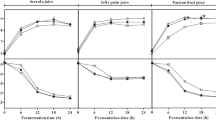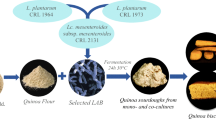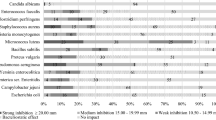Abstract
Microbial processes are being developed to transform flavonoid glycosides to varieties of metabolites with higher bioavailability. The aim of this study was to determine the metabolic activity and survival of five lactic acid bacteria (LAB) stains (L. rhamnosus LRa05, L. casei LC89, L. plantarum N13, L. acidophilus LA85, and L. brevis LB01) in two different citrus flavanone standards (hesperetin-7-O-rutinoside and naringenin-7-O-rutinoside). The enzymatic activity, metabolites, antioxidant activities, and α-glucosidase inhibition property in the two standards were also investigated before and after incubated with LAB. The medium contained standards permitted survival of the five LAB stains. All strains exhibited β-glucosidase activity. Of the five LAB strains tested, just L. plantarum N13 and L. brevis LB01 have the ability to metabolize hesperetin-7-O-rutinoside, only L. plantarum N13, L. acidophilus LA85, and L. brevis LB01 could metabolize naringenin-7-O-rutinoside, moreover, L. acidophilus LA85l was the strain with the highest biotransformation ratio of naringenin-7-O-rutinoside. L. acidophilus LA85 and L. plantarum N13 can degrade naringenin-7-O-rutinoside into naringenin. L. brevis LB01 can degrade hesperetin-7-O-rutinoside into hesperetin, 3-(4′-hydroxyphenyl)-2-propenoic acid, 3-(3′-hydroxy-4′-methoxyphenyl)hydracrylic acid, and 3-(4′-hydroxyphenyl)propionic acid. Incubation of L. acidophilus LA85 in naringenin-7-O-rutinoside solution supposed no apparent influence in the biological activities that tested. L. acidophilus LA85 may potentially contribute to the bioavailability of citrus flavanones, and to be applied as functional cultures to obtain more bioavailable and bioactive metabolites in food products or in the human gastrointestinal tract.





Similar content being viewed by others
References
Laura M, Elisa MM, Villar CJ et al (2014) Bioavailability of dietary polyphenols and gut microbiota metabolism: antimicrobial properties. Biomed Res Int 11:905215
Zhang H, Tsao R (2016) Dietary polyphenols, oxidative stress and antioxidant and anti-inflammatory effects. Curr Opin Food Sci 8:33–42
Mohammed KH, Ahmed AD, Jihae H et al (2016) Molecular mechanisms of the anti-obesity and anti-diabetic properties of flavonoids. Int J Mol Sci 17(4):569
Kandhare AD, Ghosh P, Bodhankar SL (2014) Naringin, a flavanone glycoside, promotes angiogenesis and inhibits endothelial apoptosis through modulation of inflammatory and growth factor expression in diabetic foot ulcer in rats. Chem Biol Interact 219:101–112
Davide B, Giuseppe G, Ersilia B et al (2017) Flavanones: citrus phytochemical with health-promoting properties. BioFactors 43(4):495
Heim KE, Tagliaferro AR, Bobilya DJ (2002) Flavonoid antioxidants: chemistry, metabolism and structure-activity relationships. J Nutr Biochem 13(10):572–584
Gonzales GB, Smagghe G, Grootaert C et al (2015) Flavonoid interactions during digestion, absorption, distribution and metabolism: a sequential structure–activity/property relationship-based approach in the study of bioavailability and bioactivity. Drug Metab Rev 47(2):175–190
Schwab M (2015) Gastrointestinal absorption and metabolism of hesperetin-7-O-rutinoside and hesperetin-7-O-glucoside in healthy humans. Mol Nutr Food Res 59(9):1651–1662
Parshikov IA, Sutherland JB (2015) Biotransformation of steroids and flavonoids by cultures of Aspergillus niger. Appl Biochem Biotechnol 176(3):903–923
Lee NK, Paik HD (2017) Bioconversion using lactic acid bacteria: ginsenosides, GABA, and phenolic compounds. J Microbiol Biotechnol 27(5):869
Izumi T, Piskula MK, Osawa S et al (2000) Soy isoflavone aglycones are absorbed faster and in higher amounts than their glucosides in humans. J Nutr 130(7):1695–1699
Nielsen ILF, Chee WSS et al (2006) Bioavailability is improved by enzymatic modification of the citrus flavonoid hesperidin in humans: a randomized, double-blind, crossover Trial1. J Nutr 136(2):404–408
Li YM, Li XM, Li GM et al (2008) In Vivo Pharmacokinetics of hesperidin are affected by treatment with glucosidase-like BglA protein isolated from yeasts. J Agric Food Chemist 56(14):5550–5557
de Araújo M, Branco EM, Moreira Franco YE, Alberto TG et al (2013) Enzymatic de-glycosylation of rutin improves its antioxidant and antiproliferative activities. Food Chem 141(1):266–273
Abdella A, El-Baz AF, Ibrahim IA et al (2017) Biotransformation of soy flour isoflavones by Aspergillus niger NRRL 3122 β-glucosidase enzyme. Nat Prod Res 32(2):1–10
Ewe JA, Abdullah WNW, Bhat R et al (2012) Enhanced growth of lactobacilli and bioconversion of isoflavones in biotin-supplemented soymilk upon ultrasound-treatment. Ultrason Sonochem 19(1):160–173
Lee M, Hong GE, Zhang H et al (2015) Production of the isoflavone aglycone and antioxidant activities in black soymilk using fermentation with Streptococcus thermophiles S10. Food Sci Biotechnol 24(2):537–544
Di Gioia D, Strahsburger E, Lopez LAM et al (2014) Flavonoid bioconversion in Bifidobacterium pseudocatenulatum B7003: A potential probiotic strain for functional food development. J Funct Foods 7:671–679
You HJ, Ahn HJ, Kim JY et al (2015) High expression of beta-glucosidase in Bifidobacterium bifidum BGN4 and application in conversion of isoflavone glucosides during fermentation of soy milk. J Microbiol Biotechnol 25(4):469–478
Blanca EL, Cerrillo I, Gil-Izquierdo A et al (2016) Effect of thermal processing on the profile of bioactive compounds and antioxidant capacity of fermented orange juice. Int J Food Sci Nutr 67(2):779–788
Cagno RD, Coda R, Angelis MD et al (2013) Exploitation of vegetables and fruits through lactic acid fermentation. Food Microbiol 33(1):1–10
Kandylis P, Pissaridi K, Bekatorou A et al (2016) Dairy and non-dairy probiotic beverages. Curr Opin Food Sci 7:58–63
Kwaw E, Ma Y, Tchabo W et al (2018) Effect of lactobacillus strains on phenolic profile, color attributes and antioxidant activities of lactic-acid-fermented mulberry juice. Food Chem 250:148–154
Héctor R, José AC, José ML et al (2009) Food phenolics and lactic acid bacteria. Int J Food Microbiol 132(2–3):79–90
Michlmayr H, Kneifel W (2013) β-Glucosidase activities of lactic acid bacteria: mechanisms, impact on fermented food and human health. FEMS Microbiol Lett 352(1):1
Liu WS, Yang CY, Fang TJ (2018) Strategic ultrasound-induced stress response of lactic acid bacteria on enhancement of β-glucosidase activity for bioconversion of isoflavones in soymilk. J Microbiol Methods 148:145–150
Lopez de Lacey AM, Perez-Santin E, Lopez-Caballero ME (2014) Survival and metabolic activity of probiotic bacteria in green tea. LWT Food Sci Technol 55(1):314–322
Izzo V, Tedesco P, Notomista E, Pagnotta E, Di Donato A, Trincone A et al (2014) α-Rhamnosidase activity in the marine isolate novosphingobium sp. pp1y and its use in the bioconversion of flavonoids. J Mol Catal B Enzym 105:95–103
Guo X, Cao X, Guo A, Li E (2019) Improving the taste of Ougan (Citrus reticulate cv Suavissima) juice by slight fermentation with lactic acid bacteria. J Food Process Preserv. https://doi.org/10.1111/jfpp.14056
Phan MAT, Wang J, Tang J et al (2013) Evaluation of α-glucosidase inhibition potential of some flavonoids from Epimedium brevicornum. LWT Food Sci Technol 53(2):492–498
Cai S, Cao J, Han P et al (2015) Digestion property and synergistic effect on biological activity of purple rice (Oryza sativa L.) anthocyanins subjected to a simulated gastrointestinal digestion in vitro. Food Res Int 78:114–123
Rafinska K, Pomastowski P, Rudnicka J et al (2019) Effect of solvent and extraction technique on composition and biological activity of Lepidium sativum extracts. Food Chem 289:16–25
Patel K, Singh GK, Patel DK (2018) A review on pharmacological and analytical aspects of naringenin. Chin J Integrat Med 24(7):551–560
Duda-Chodak A (2012) The inhibitory effect of polyphenols on human gut microbiota. J Physiol Pharmacol 63(5):497–503
Schneider H, Schwiertz A, Collins MD et al (1999) Anaerobic transformation of quercetin-3-glucoside by bacteria from the human intestinal tract. Arch Microbiol 171(2):81–91
Mueller M, Zartl B, Schleritzko A et al (2018) Rhamnosidase activity of selected probiotics and their ability to hydrolyse flavonoid rhamnoglucosides. Bioprocess Biosyst Eng 41:221–228
de López L, Ana M, Pérez-Santín, et al (2014) Biotransformation and resulting biological properties of green tea polyphenols produced by probiotic bacteria. LWT Food Sci Technol 58(2):633–638
Pereira-Caro G, Fernández-Quirós B, Ludwig IA et al (2016) Catabolism of citrus flavanones by the probiotics Bifidobacterium longum and Lactobacillus rhamnosus. Eur J Nutr 57(1):1–12
Pereira-Caro G, Borges G, Ky I et al (2015) In vitro colonic catabolism of orange juice (poly)phenols. Mol Nutr Food Res 59(3):465–475
Queiroz Santos VA, Nascimento CG, Schimidt CAP et al (2018) Solid-state fermentation of soybean, okara: Isoflavones biotransformation, antioxidant activity and enhancement of nutritional quality. LWT Food Sci Technol 92:509–515
Serra A, Alba M, Romero MP et al (2012) Metabolic pathways of the colonic metabolism of flavonoids (flavonols, flavones and flavanones) and phenolic acids. Food Chem 130(2):383–393
Acknowledgements
Thanks Jiangsu Wecare Biotechnology Co., Ltd (Suzhou, China) for providing lactic acid bacteria strains. This research was supported by Fundamental Research Funds for the National Natural Science Foundation of China (31771947). The requirement of managing all communication between the journal and all co-authors during submission and proofing are delegated to Submitting Author.
Author information
Authors and Affiliations
Corresponding author
Ethics declarations
Conflict of interest
The authors declare that they have no conflict of interest.
Additional information
Publisher's Note
Springer Nature remains neutral with regard to jurisdictional claims in published maps and institutional affiliations.
Electronic supplementary material
Below is the link to the electronic supplementary material.
449_2020_2437_MOESM1_ESM.tif
Supplementary Figure 1 Extracted ion chromatograms of bacterial flavanone metabolites. (A) 72 h incubation of naringenin-7-O-rutinoside (20 mg/L) with L. acidophilus LA85, (B) 72 h incubation of naringenin-7-O-rutinoside (20 mg/L) with L. plantarum N13, (C) 72 h incubation of hesperetin-7-O-rutinoside with L. brevis LB01 (TIF 946 kb)
449_2020_2437_MOESM2_ESM.tif
Supplementary Figure 2 Chromatograms (A270nm) of 72 h incubation of naringenin-7-O-rutinoside (20 mg/L) with L. acidophilus LA85 (black line), 72 h incubation of naringenin-7-O-rutinoside (20 mg/L) without L. acidophilus LA85 (blue line, control 1), 72 h incubation of L. acidophilus LA85 without naringenin-7-O-rutinoside (green line, control 2). Peak 1: naringenin-7-O-rutinoside, peak 2: naringenin (TIF 736 kb)
449_2020_2437_MOESM3_ESM.tif
Supplementary Figure 3 Chromatograms (A270nm) of 72 h incubation of naringenin-7-O-rutinoside (20 mg/L) with L. plantarum N13 (black line), 72 h incubation of naringenin-7-O-rutinoside (20 mg/L) without L. plantarum N13 (blue line, control 1), 72 h incubation of L. plantarum N13 without naringenin-7-O-rutinoside (green line, control 2). Peak 1: naringenin-7-O-rutinoside, peak 2: naringenin (TIF 738 kb)
Rights and permissions
About this article
Cite this article
Guo, X., Guo, A. & Li, E. Biotransformation of two citrus flavanones by lactic acid bacteria in chemical defined medium. Bioprocess Biosyst Eng 44, 235–246 (2021). https://doi.org/10.1007/s00449-020-02437-y
Received:
Accepted:
Published:
Issue Date:
DOI: https://doi.org/10.1007/s00449-020-02437-y




